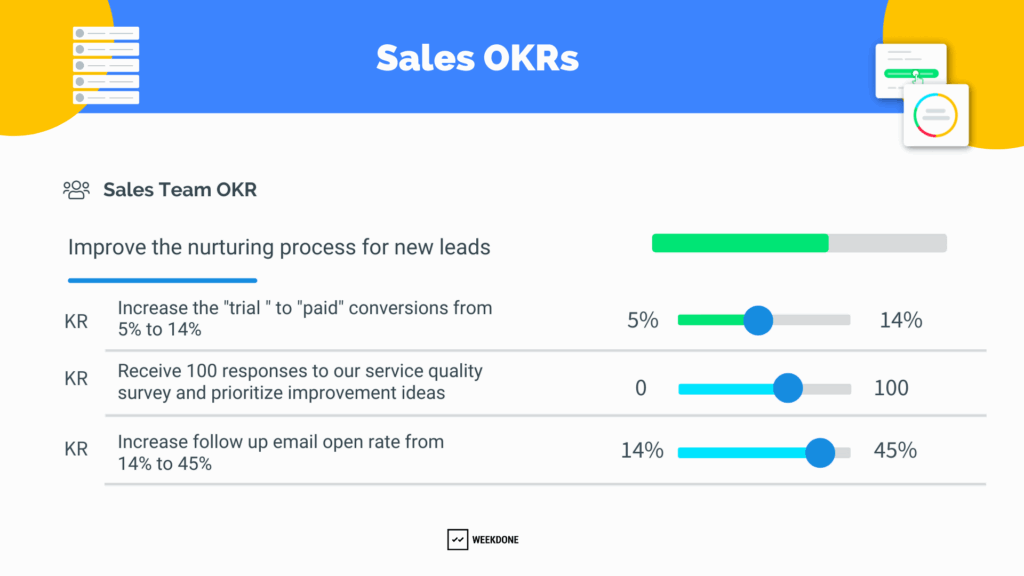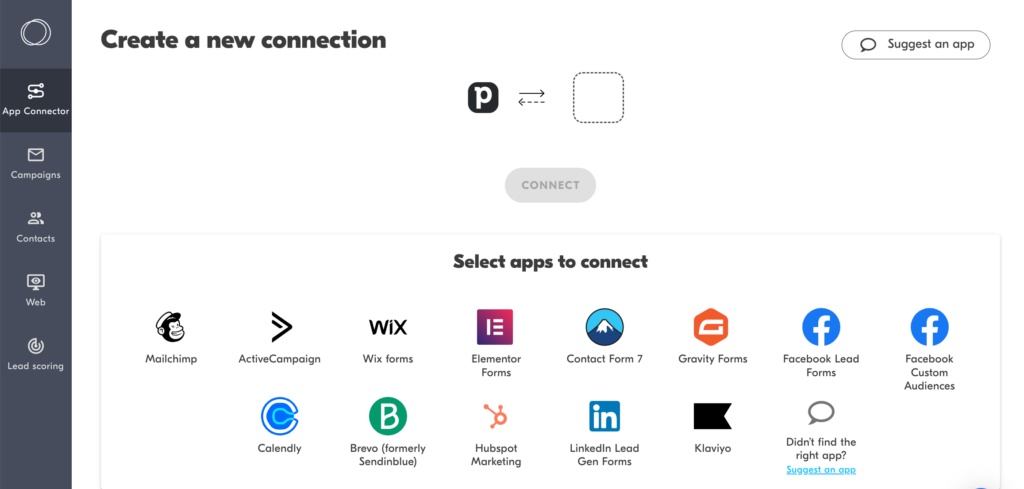A (mis)aligned team impacts every aspect of your business, even your revenue. In fact, companies struggling with sales and marketing alignment are twice as likely to miss revenue goals.
But, most companies need help to keep marketing and sales on the same page.
We’ve repeatedly surveyed sales and marketing teams if their marketing and sales teams were aligned. Only 41% rated their marketing and sales alignment as “very good” or “excellent”. Most teams agree there is room for improvement in getting their sales and marketing teams to see eye to eye.

In this guide, we share:
- Why it’s important to align marketing and sales
- The most common challenges you’ll face
- How to align marketing and sales (step-by-step)
What is marketing and sales alignment?
Marketing and sales alignment is the process of collaboration between sales and marketing teams to achieve shared goals.
Misaligned teams work in a silo, worrying only about their isolated goals and metrics. Aligned teams keep each other up to date, support each other, and collaborate on shared projects.
Simply put, they work together to achieve business goals such as growing the customer base, increasing revenue, or improving retention.
Why is marketing-sales alignment important?
If marketing has no clue what sales does, and sales think marketing isn’t helping their goals, you can expect missed targets and finger-pointing.
But both teams can be more efficient when sales and marketing align, providing prospects with a seamless customer journey. This can positively impact lead generation, conversion rates and revenue.
Companies with seamless sales and marketing collaboration see more revenue growth than businesses with ineffective sales and marketing cooperation. Revenue growth is 70% more common among companies where sales and marketing cooperate effectively.
Among teams who strongly agree that their sales and marketing teams cooperate effectively, 73% saw revenues increase year over year. Looking at respondents who think their teams don’t cooperate effectively, only 43% saw revenues increase.
The dysfunctional relationship between sales and marketing is hurting business’ top lines. It’s clear that companies still have a lot to do to improve their internal relationships, both for alignment and revenue-driving purposes. Taking the time to build, foster and maintain relationships between sales and marketing teams is now more important than ever as buyers are engaging sales later in the buying process.
Dennis Fois, CEO, Copper
Challenges in aligning marketing and sales
Before we go into fixing marketing-sales misalignment, we should understand what’s causing it.
What are the biggest obstacles for marketing and sales teams?

Poor communication is the main component behind failed alignment. Over 40% of teams reported poor communication as the biggest obstacle to the joint success of marketing and sales. As teams grow, communication becomes an even bigger issue.
Another common speedbump, especially for larger teams, is the lack of accountability, which often stems from poor communication. When teams don’t clearly communicate their responsibilities, objectives, and key results, maintaining accountability becomes impossible. With both teams operating in a silo, each team can easily assume they’re the only ones doing the hard work.
Smaller businesses face a different challenge: the lack of accurate data on prospects and customers. Without full access to customer data, both marketing and sales teams are left in the dark, which can severely impact the bottom line in the long run.
How to align marketing and sales
So, what are the well-aligned teams doing differently?
Here are 5 actionable steps you can take to create harmony between marketing and sales in your business.
1. Agree on the ICP (Ideal Customer Profile)
Before you start working on strategy, make sure marketing and sales are on the same page about who the ideal customer is.
Any disconnect here can lead to wasted resources and missed opportunities. That’s why sales and marketing should collaborate to create a detailed description of the perfect customer, including their needs, behaviors, and pain points.
Either build a new document for this purpose or review your existing one with input from both teams. Doing this ensures everyone is targeting the same customer profiles.
Regularly update your ICP to reflect any changes in the market or customer base. Make sure both teams are involved in updates to stay on the same page as the customer profile evolves.

2. Define objectives, key results, and plans together
If marketing and sales don’t see eye to eye, it’s time to question whether incentives are misaligned. Marketing and sales goals need to be synchronized, and both teams should know each other’s goals.
If the number of leads is your only measure of success for marketing, the team might pay more attention to quantity regardless of quality. Sales will be frustrated when they see a bunch of low-quality leads. In the long run, it’ll hurt the business, and harm revenue and growth.
Thibaut Davoult, Livestorm’s VP of Growth Ops, notes the importance of helping each team understand the big picture instead of focusing on isolated metrics.
What matters is the bottom line, not increasing one metric at the detriment of the rest.
Thibaut Davoult, VP, Growth Ops, Livestorm
At Outfunnel, we track marketing and sales KPIs together. Why? Because traffic, signups, and conversions, as well as the numbers of new leads, new customers, and churned customers, all impact the bottom line.
An efficient way to align teams is to set OKRs (Objectives and Key Results) together. This is a collaborative goal-setting methodology that involves defining objectives and the key results that measure success. As explained by John Doerr in his book Measure What Matters, objectives describe what you want to achieve, while key results measure your success toward your objectives.

The OKR methodology boosts cross-team communication and collaboration. Each team’s OKRs are connected to company OKRs and communicated with other teams. This ensures all teams work together towards the company’s mission and objective.
A practical way to align sales and marketing is to set a shared objective that both teams work together to achieve. Each team can have their individual key results that contribute to this shared objective.
3. Fix cross-team communication
If you’re making an effort to align teams, improving communication is a no-brainer. But it’s easier said than done.
The first step is to define clear channels for communication. What information should each team share and what’s the best place to share it? What material should marketing develop to assist sales? What information can sales share to help marketing attract more qualified leads?
5 ways to improve communication between sales and marketing:
- Regular Meetings: Schedule regular meetings between sales and marketing teams. You can use these meetings to share insights and progress, discuss challenges, and plan collaborative tasks. For example, Userlike holds weekly calls for sales and marketing leads as well as bi-weekly “synergy meetings”, attended by people from marketing, sales and support.
- Real-time communication: Use your company’s communication platform to collaborate and keep everyone in the loop. Have a dedicated channel for both sales and marketing to share day-to-day updates and insights from customers.
- Monthly reports: Share monthly reports where both teams show what they’ve worked on past month, discuss results and provide insights. At Outfunnel, the monthly sales report includes useful info for the marketing team, such as why trial users are not buying our subscription.
- Sales calls recordings: Listening to recorded sales calls can help marketing keep up with sales, gain new customer insights and come up with content ideas.
- Feedback loops: Create feedback loops to identify what’s working, what’s not, and how processes can be improved. Hold monthly feedback sessions to discuss successes and challenges or use surveys to gather input from both teams.
4. Find ways to offer and ask for support
Recognize that marketing and sales teams are in service to each other.
There are too many marketing and sales teams that dislike working together and are fast to blame each other. But you don’t have to be one of those teams. After all, you’re working towards the same vision, and each team’s success should make the other team’s job easier.
As a CMO, my team and I are in service to our sales team. This leads to a culture of respect, cooperation, and reciprocation. Rather than being the marketer who thinks poorly of sales because they don’t call your leads, become a bigger thinker. Become the marketer who’s focused on creating an indisputably great pipeline.
Carrie Shaw, CMO, Copper
If you’re a salesperson, don’t hesitate to share customer insights and even content ideas with your marketing team. The marketing team will benefit from getting unbiased and thoughtful data from sales.
If you’re a marketer, make use of the sales team. They’re the ones who are in direct contact with customers which makes them experts on frequently asked questions, customers’ needs and pain points. Use this information when putting together your content calendar and support the sales team with marketing material they need for one-on-one conversations with customers.
You can even consider developing a content calendar that both teams can access. This ensures that marketing campaigns and sales efforts are synchronized.
5. Connect marketing and sales data
Lack of accurate data on prospects and customers is the second-biggest threat to joint sales and marketing success. When data is siloed, it’s difficult for either team to get a full picture of the customer journey and make the right decisions.

That’s why making sure data flows across teams should be high up on every business’s priority list.
Even though data is key to alignment, over a third of SMBs still move data between tools manually, which leads to inaccurate or out-of-date information.
Sharing data between all tools and creating automations between tools is key. As well as making data easily accessible.
Thibaut Davoult, VP, Growth Ops @Livestorm
When asked what they’d improve about sales and marketing tools, nearly half (47%) of teams pointed out the need to easily integrate their tools. On average, sales and marketing teams use 2-3 teams each, so making all these tools work together is crucial.
How can you integrate sales and marketing data?
- Use a CRM with built-in marketing automation functionality: Choose a CRM that allows for seamless data sharing between marketing and sales. It should provide a single source of truth and give both teams the latest data.
- Automate data sharing between sales and marketing apps: Tools like Outfunnel help with sales and marketing alignment, as they synchronize data between your sales and marketing apps.
With integrated sales and marketing data, both teams can be more efficient. Sales will be able to view enriched lead profiles and see all of their leads’ activity before they get to the sales part of the funnel. Marketing won’t just hand off leads to sales. Instead, they’ll be able to follow their leads throughout the entire customer journey.
Keeping data in sync is a crucial step in aligning your marketing and sales. So, make sure you choose an automation tool that keeps your data in sync with sales processes 24/7 (hint: Outfunnel can help with that).

Final thoughts
Aligning marketing and sales is not just a nice-to-have but a necessity for business growth. By setting shared goals, improving communication, and integrating data, you’ll be on the right path toward true alignment of marketing and sales teams.
It’s not easy. It might require many iterations. It will be continuous work. But the rewards of a more cohesive team, improved customer experience, and increased revenue—are well worth it.
P.S. If you’ve made it this far and want to take the first step by connecting the data between all your sales and marketing tools, maybe try Outfunnel free for 2 weeks?



